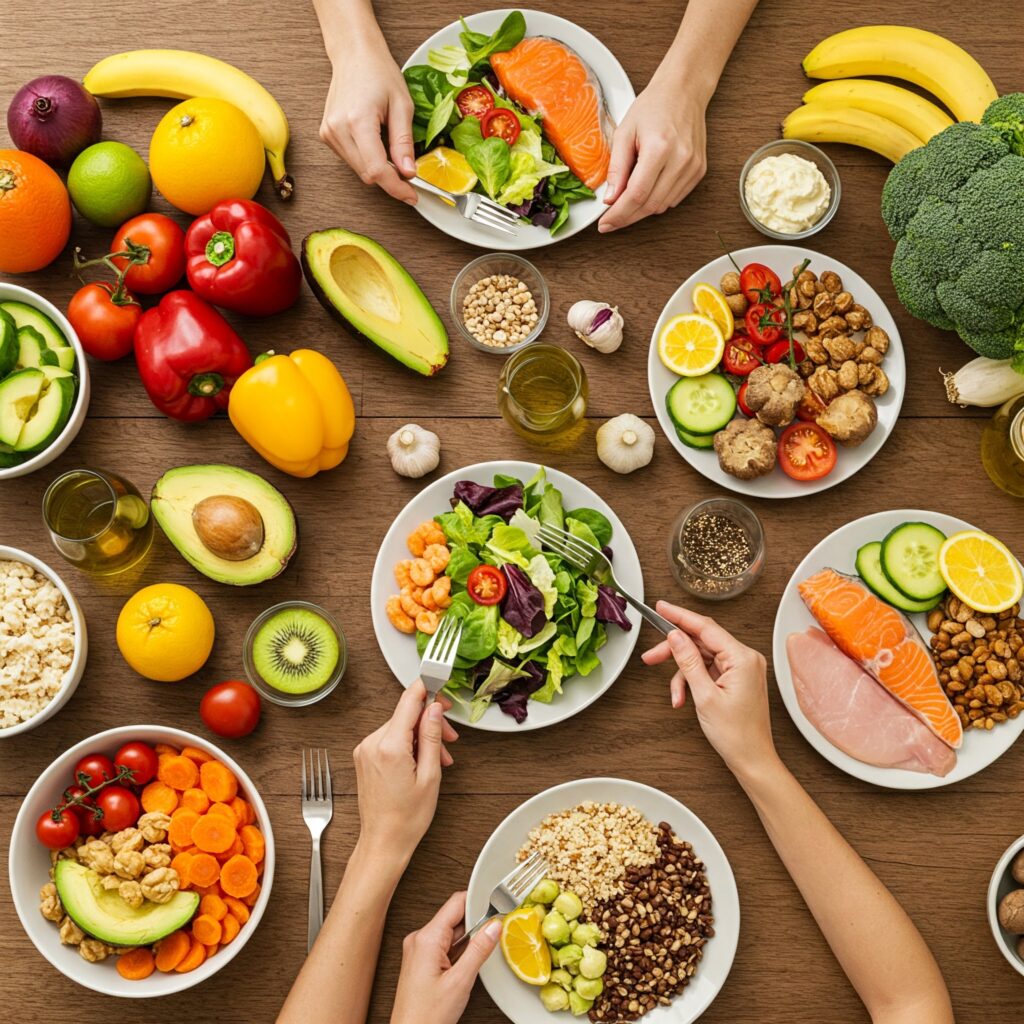Set A: Nutrition and Health
Question 1
What is polio, and how can it be prevented?
Answer: Polio is a disease caused by a virus that can lead to paralysis. To prevent polio, polio drops are administered to children under five years of age to vaccinate them against the disease.
Question 2
Explain the importance of food for our body.
Answer: Food nourishes our body, providing energy, promoting growth, and preventing us from falling sick. It contains essential substances called nutrients, which are required for the proper functioning of our body.
Question 3
List the five main nutrients present in food and their primary functions.
Answer: The five main nutrients present in food are:
- Carbohydrates: Provide energy for daily activities.
- Proteins: Help in growth and repair of body tissues.
- Fats: Provide more energy than carbohydrates and are essential for the body.
- Vitamins: Required in small amounts for normal body functions.
- Minerals: Necessary for proper functioning and maintenance of body structures.
Question 4
What are energy-giving nutrients, and give examples?
Answer: Energy-giving nutrients provide the body with energy to perform daily activities. Examples include carbohydrates and fats. Carbohydrates are found in foods like rice, bread, and potatoes. Fats are present in foods such as butter, cheese, and nuts.
Question 5
Why are proteins important for the body? Mention some sources of proteins.
Answer: Proteins are important because they help in the growth and repair of body tissues, including muscles, blood, and skin. They also play a role in the generation of new cells. Sources of proteins include eggs, soybean, milk, cheese, and pulses.
Question 6
Describe the role of vitamins in maintaining health and list some sources.
Answer: Vitamins are essential for the normal functioning of the body and are needed in small amounts. They help prevent diseases and maintain overall health. Sources of vitamins include green leafy vegetables, fruits, eggs, and fish.
Question 7
What are minerals, and why are they important for the body? Provide examples of minerals and their sources.
Answer: Minerals are nutrients needed to keep the body healthy and ensure proper functioning. Examples include iron, calcium, potassium, and iodine. Minerals are found in fruits, vegetables, dairy products, and meats.
Set B: Water, Roughage, and Balanced Diet
Question 1
Why is water essential for our body?
Answer: Water is essential for our body as it is necessary for proper functioning, including the movement of food through the stomach and intestines, and the removal of waste through sweat and urine. We cannot live without water.
Question 2
What is roughage, and why is it important for our digestive system?
Answer: Roughage, also known as dietary fiber, is present in plant foods like vegetables, fruits, and grains. It is not digested by our body but helps in the movement of food through the stomach and intestines. Roughage adds bulk to the undigested food and keeps the intestine in shape.
Question 3
Define a balanced diet and explain its importance.
Answer: A balanced diet includes appropriate amounts of all the nutrients required for our body to stay strong and healthy. Since no single type of food provides all the necessary nutrients, a balanced diet consists of different types of food that together meet our nutritional needs. It ensures that the body gets all the nutrients in the correct amounts.
Question 4
According to the pie chart of a balanced diet, how many servings of rice, cereals, and fruits and vegetables should be consumed daily?
Answer: The pie chart of a balanced diet suggests that one should consume 5-7 servings of rice and cereals and 2-3 servings of fruits and vegetables daily.
Question 5
What types of foods should be included in a protein-rich diet?
Answer: A protein-rich diet should include foods obtained from dairy products or non-dairy products, such as pulses. It is recommended to consume 2-3 servings of dairy products and other protein-rich foods.
Question 6
How should oil, fat, and sugar be consumed in a balanced diet?
Answer: In a balanced diet, oil, fat, and sugar should be consumed in very small amounts to maintain good health and avoid excess calorie intake.
Set C: Exercise, Sleep, and Diseases
Question 1
Why is it important to exercise regularly and take proper sleep in addition to eating a balanced diet?
Answer: Regular exercise and proper sleep are important in addition to eating a balanced diet because they help keep us fit and healthy. Exercise helps in maintaining physical fitness, while proper sleep ensures that our body functions optimally and helps in overall well-being.
Question 2
Explain the concept of essential nutrients with an example.
Answer: Essential nutrients are those that animals, including humans, must obtain from external food sources because their bodies cannot produce them. For example, humans cannot make vitamin C in their body and must obtain it from food sources. However, cows can produce vitamin C in their bodies, so it is not an essential nutrient for them.
Question 3
Define disease and describe its impact on the body.
Answer: A disease is an abnormal condition of the body in which normal body functions are disturbed, making us weak and sick. Diseases can cause various changes in the body, such as fever, fatigue, and pain, affecting our overall health.
Question 4
What are the two main types of diseases?
Answer: The two main types of diseases are:
- Communicable diseases
- Non-communicable diseases
Question 5
What are communicable diseases and how do they spread?
Answer: Communicable diseases, also known as infectious or contagious diseases, can spread from an infected person to a healthy person. These diseases are caused by germs and spread through various modes of transmission such as air, water, direct contact, or vectors.
Set D: Modes of Transmission and Prevention of Communicable Diseases
Question 1
How do air-borne diseases spread and name some examples?
Answer: Air-borne diseases spread when an infected person sneezes, coughs, or spits, releasing germs into the air. When a healthy person breathes in this contaminated air, germs enter their body. Examples of air-borne diseases include common cold, viral flu, and measles.
Question 2
What happens when food is contaminated, and which diseases can result from consuming contaminated food or water?
Answer: When food is kept uncovered, it can get contaminated by germs from dust, dirt, and insects like houseflies and cockroaches. Consuming contaminated food or water can lead to diseases such as diarrhea, typhoid, jaundice, and cholera.
Question 3
Describe how direct or indirect contact can spread communicable diseases and provide examples.
Answer: Communicable diseases can spread through direct contact, such as touching an infected person or a handshake, or through indirect contact, like using an infected person’s towel or handkerchief. Examples of diseases spread this way include common cold, chickenpox, and ringworm.
Question 4
How do insects contribute to the spread of diseases? Provide examples of diseases spread by insects.
Answer: Insects like mosquitoes, fleas, and houseflies spread diseases. Mosquitoes spread diseases like malaria and dengue by sucking blood from an infected person and transferring germs to a healthy person. Fleas spread plague, and houseflies carry germs on their body from dirty surfaces.
Question 5
List some measures to prevent the spread of communicable diseases.
Answer: Measures to prevent the spread of communicable diseases include:
- Maintaining personal hygiene (daily baths, washing hands before eating).
- Keeping the house clean and using disinfectants.
- Using mosquito nets and repellants, and removing stagnant water to prevent mosquito breeding.
- Boiling water or using water purifiers to kill germs.
- Avoiding food from untidy places and maintaining clean surroundings.
Question 6
What role do vaccinations play in preventing diseases, and who benefits most from them?
Answer: Vaccinations help prevent diseases by producing immunity in the body to fight against germs. Children benefit the most from vaccinations as they prepare their young bodies to fight against serious diseases such as tuberculosis, polio, diphtheria, pertussis, tetanus, and measles.
Question 7
Explain the difference between communicable and non-communicable diseases.
Answer: Communicable diseases can spread from an infected person to a healthy person through various modes of transmission such as air, water, direct contact, and insects. Non-communicable diseases cannot spread from person to person and often result from deficiencies in vitamins and minerals, hence they are also known as deficiency diseases.
Question 8
Tabulate the differences between communicable and non-communicable diseases.
Answer:
| Aspect | Communicable Diseases | Non-Communicable Diseases |
|---|---|---|
| Definition | Diseases that can spread from one person to another. | Diseases that cannot spread from person to person. |
| Causes | Caused by germs such as bacteria, viruses, fungi, etc. | Caused by lifestyle factors, genetic factors, or deficiencies in vitamins and minerals. |
| Examples | Common cold, flu, measles, chickenpox, malaria, dengue. | Diabetes, heart disease, cancer, deficiency diseases like scurvy. |
| Mode of Transmission | Air, direct or indirect contact, contaminated food/water, insects. | Not applicable (cannot be transmitted). |
| Prevention | Personal hygiene, vaccinations, avoiding contact with infected individuals. | Healthy lifestyle, balanced diet, regular exercise. |
Set E: Deficiency Diseases, Inherited Diseases, and Vaccination
Question 1
What are deficiency diseases and how can they be prevented?
Answer: Deficiency diseases occur due to a lack of essential vitamins or minerals in the diet. They can be prevented by consuming a balanced diet that includes a variety of foods rich in essential nutrients.
Question 2
Provide examples of deficiency diseases, the corresponding vitamin or mineral deficiency, their symptoms, and preventive measures.
Answer:
| Deficiency Disease/Disorder | Vitamin/Mineral | Symptoms | Preventive Measures |
|---|---|---|---|
| Night blindness | Vitamin A | Poor vision, loss of vision in darkness | Take carrot, green leafy vegetables, sweet potato, coloured vegetables, and milk. |
| Beriberi | Vitamin B1 | Nerve disorder that can affect muscles and heart | Take unpolished rice, cereals, milk, and fish. |
| Scurvy | Vitamin C | Bleeding gums, wounds take longer to heal | Take tomato, green vegetables, citrus fruits like orange, etc. |
| Rickets/Osteomalacia | Vitamin D | Soft and weak bones, bone deformities in children, brittle bones in adults | Take milk, milk products, fish, and eggs. |
| Bones and tooth decay | Calcium | Soft and weak bones, tooth decay | Take milk, milk products, and green leafy vegetables. |
| Goitre | Iodine | Swelling in the neck and mental disability in children | Take iodised salt and fish. |
| Anaemia | Iron | Weakness and tiredness | Take spinach, apple, pomegranate, raisins, and sweet potato. |
Question 3
Explain the role of Edward Jenner in the discovery of vaccination.
Answer: Edward Jenner discovered the process of vaccination in 1796. He derived the word vaccine from the Latin word ‘Vacca’, which means cow. Jenner found that milkmaids who had contracted cowpox did not get smallpox. He confirmed his observations by experimenting on a healthy 8-year-old boy, James Phipps, by infecting him with cowpox and later with smallpox. The boy did not develop smallpox, indicating immunity. This led to the discovery of the smallpox vaccine.
Question 4
What are non-communicable diseases, and how are they different from communicable diseases?
Answer: Non-communicable diseases are diseases that cannot spread from an infected person to a healthy person. They can occur due to genetic factors, lifestyle choices, or deficiencies in vitamins and minerals. Examples include diabetes, heart disease, and deficiency diseases like scurvy. In contrast, communicable diseases can spread from one person to another through various modes of transmission, such as air, water, direct contact, and insects.
Question 5
What are some inherited non-communicable diseases?
Answer: Inherited non-communicable diseases are those present from birth and not related to lifestyle or diet. Examples include allergies to pollens or dust, diabetes, and heart problems, which can be inherited from parents.
Question 6
What measures can be taken to prevent deficiency diseases?
Answer: To prevent deficiency diseases, it is important to consume a balanced diet that includes a variety of foods rich in essential vitamins and minerals. For example:
- Vitamin A: Carrot, green leafy vegetables, sweet potato, milk.
- Vitamin B1: Unpolished rice, cereals, milk, fish.
- Vitamin C: Tomato, green vegetables, citrus fruits.
- Vitamin D: Milk, milk products, fish, eggs.
- Calcium: Milk, milk products, green leafy vegetables.
- Iodine: Iodised salt, fish.
- Iron: Spinach, apple, pomegranate, raisins, sweet potato.
Question 7
Define the following terms:
Answer:
| Term | Definition |
|---|---|
| Nutrients | Substances present in food that are essential for our body. |
| Balanced diet | A diet that contains different foods in appropriate amounts to meet our nutrient requirements. |
| Disease | An abnormal condition of the body in which body functions get disturbed. |
| Communicable disease | A disease that can spread from an infected person to a healthy person. |
| Non-communicable disease | A disease that cannot spread from an infected person to a healthy person. |
| Immunity | The natural ability of the body to fight against germs and prevent infection. |
| Vaccine | A substance that provides immunity or boosts natural immunity to fight against germs. |



